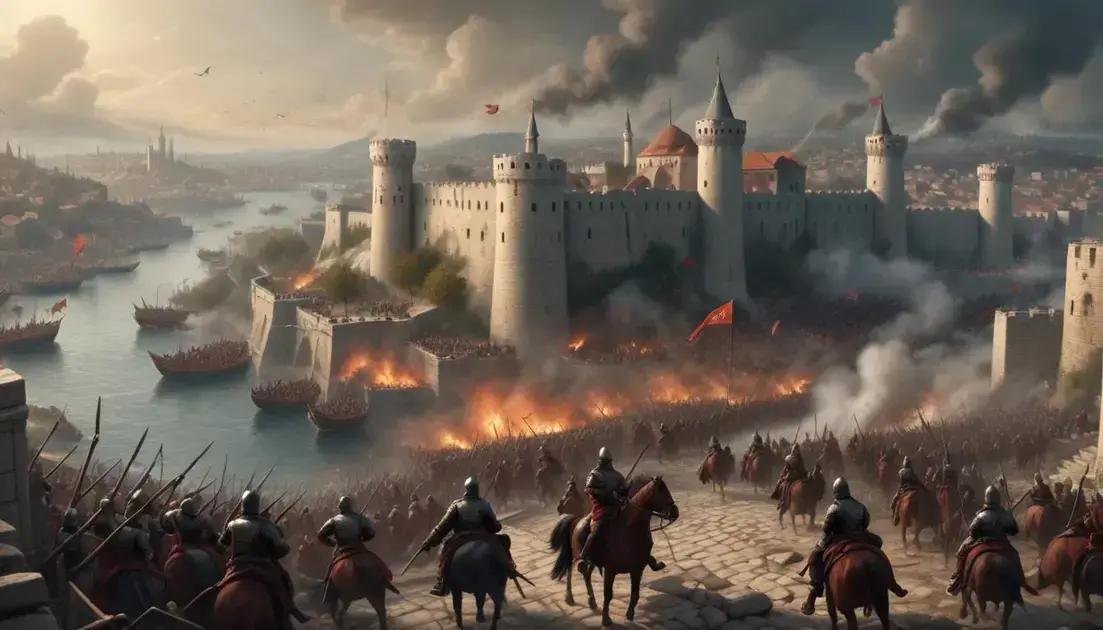
The Fall of Constantinople: End of the Middle Ages
The Fall of Constantinople in 1453 marked a crucial turning point in history, ending the Byzantine Empire and establishing the Ottoman Empire as a dominant power. This significant event resulted in massive cultural and religious shifts, including the conversion of churches into mosques and the blending of Byzantine and Islamic influences. The fall also led to the migration of scholars to Western Europe, sparking the Renaissance. Overall, the fall transformed trade routes and had lasting effects on art, culture, and religion, shaping the future of both Europe and the Middle East.
The Fall of Constantinople in 1453 marked a pivotal moment in history, transforming the Mediterranean landscape forever. Have you ever wondered how one city’s fall changed the course of empires?
Introduction to the Fall of Constantinople
The Fall of Constantinople was a significant event in 1453. It marked the end of the Byzantine Empire. This city, once a thriving center of trade and culture, faced a formidable siege by the Ottoman Empire. The fall of this city changed the course of history.
Constantinople’s strategic location made it a prime target. It connected Europe and Asia. The Ottomans, led by Sultan Mehmed II, had a well-planned strategy. Their forces used innovative tactics to breach the walls of the city.
The Siege Begins
As the siege began, the citizens of Constantinople prepared for a tough battle. They strengthened their defenses, hoping to withstand the Ottoman onslaught. The city’s walls had stood for over a thousand years. But the Ottomans brought massive cannons that could break through even the strongest fortifications.
Life During the Siege
Life in the city changed drastically. Supplies dwindled, and fear spread. Citizens turned to their leaders for hope and guidance. Daily life was filled with tension as each day brought the threat of attack closer.
The Final Assault
On May 29, 1453, the final assault began. The Ottomans launched their attack with overwhelming force. The defenders fought bravely but were eventually outnumbered. The city’s walls, once thought impenetrable, finally fell.
The fall of Constantinople not only ended the Byzantine Empire but also opened the doors for the Ottomans to expand their territory further into Europe. This event signifies a major shift in world history, leading to the rise of the Ottoman Empire.
Historical Context and Significance
The historical context of the Fall of Constantinople is crucial to understanding its significance. For centuries, Constantinople was the center of the Byzantine Empire. This city held immense strategic value, connecting Europe and Asia.
Throughout its history, Constantinople was a melting pot of cultures. It attracted traders, scholars, and travelers from all over the world. The city’s architectural wonders, like the Hagia Sophia, showcased its wealth and importance.
Byzantine Decline
By the 15th century, the Byzantine Empire faced serious challenges. Constant wars and internal conflicts weakened its power. The Ottomans, under Sultan Mehmed II, were poised to take advantage of this decline.
The Rise of the Ottomans
The Ottoman Empire had been growing steadily. They conquered large parts of Eastern Europe and Asia Minor. Their army was well-trained and equipped with advanced weapons. This made them a formidable opponent.
Why the Fall Matters
When Constantinople fell in 1453, it marked the end of an era. This event symbolized the end of the Middle Ages. The Ottomans’ victory opened new trade routes and spread Islamic culture into Europe.
This shift also brought about significant changes in art, science, and religion. The fall inspired exploration and eventually led to the Renaissance in Western Europe. Understanding this context helps us see how the fall of a single city shaped the future of a continent.
The Siege Mechanics and Strategy
The siege of Constantinople was one of the most important military events in history. It showcased the Ottoman Empire’s strategy and use of technology. They came prepared with large cannons and a well-trained army.
The Ottomans first surrounded the city. They cut off supplies from reaching Constantinople. This tactic aimed to weaken the defenders. The city, known for its strong walls, faced a real challenge.
Use of Heavy Artillery
The Ottomans brought massive cannons, like the famous Basilica cannon. This cannon could break through the city’s thick walls. The sound of these cannons shook the city and boosted the soldiers’ morale.
Naval Blockade
The Ottoman navy played a vital role as well. They blocked the harbor and prevented ships from bringing in supplies. This included food and weapons, which the defenders needed to last the siege.
Psychological Warfare
The Ottomans used psychological tactics to intimidate the defenders. They launched attacks at night to create fear. Loud noises and false attacks kept the citizens on high alert. This constant pressure wore down the defenders’ spirits.
Despite fierce resistance from the Byzantines, the siege continued for weeks. The strategies employed demonstrated how careful planning and modern techniques could lead to success in warfare. The fall of the city was inevitable, given the strength of the Ottoman approach.
Impact on the Byzantine Empire
The Fall of Constantinople had a huge impact on the Byzantine Empire. This defeat ended centuries of Byzantine rule. Once a powerful empire, the Byzantines struggled to defend their capital. Losing Constantinople meant losing their leadership and influence.
Many citizens fled the city as it fell. Some sought safety in other regions, while others migrated to Western Europe. This included many scholars and artists, who took their knowledge with them. They helped spark the Renaissance in Western Europe.
Loss of Territory
With the fall, the Ottomans took control of the city. This gave them a strong foothold in Europe. Their empire continued to grow, expanding into the Balkans and beyond. The Byzantines could no longer stop their advance.
Cultural Changes
The Ottomans brought different cultural influences. They changed the religious landscape of the area. Many churches were converted into mosques. This altered the way people worshipped and practiced their faith.
Shift in Trade Routes
Before the fall, Constantinople was a key trade hub. After the city changed hands, trade routes shifted. Merchants found new paths, leading to growth in other regions. This change affected economies across Europe and Asia.
Overall, the fall of Constantinople marked the end of the Byzantine Empire. Yet, its influence lived on in other cultures. The legacy of the Byzantines continued, shaping history long after their fall.
Cultural and Religious Changes
The Fall of Constantinople led to many cultural and religious changes. Once a Christian stronghold, the city became a key center for Islam. This shift influenced many aspects of daily life.
After the fall, many churches were converted into mosques. The Hagia Sophia, a famous church, became a mosque. This change marked a new era for religious practices in the city.
Religious Tolerance
The Ottomans were known for their relatively tolerant approach. They allowed Christians and Jews to practice their faith. These communities had certain rights under Ottoman rule. They could continue their traditions, but they had to pay a tax.
Cultural Blending
The fall brought different cultures together. Byzantine art and architecture mingled with Islamic styles. This blending can be seen in mosques that feature intricate designs and calligraphy.
Impact on Education and Scholarship
Many scholars fled to Western Europe as the city fell. They brought ancient texts and knowledge with them. This helped inspire the Renaissance, a period of great learning and creativity.
Even today, the impact of these changes can be seen. The cultural exchange that happened after the fall enriched societies in both Europe and the Middle East. Understanding this legacy helps us appreciate the diversity of influences.
Conclusion
In conclusion, the Fall of Constantinople was a turning point in history. It changed the course of the Byzantine Empire and marked the rise of the Ottoman Empire. The cultural and religious shifts during this time were profound.
As the city transformed from a Christian stronghold to a center of Islam, new cultural exchanges emerged. These changes impacted art, architecture, and education for generations. Scholars fleeing the city brought valuable knowledge to the West, sparking the Renaissance.
Understanding these events helps us appreciate the rich tapestry of history. The effects of the fall continue to be felt, shaping both Eastern and Western cultures today. By recognizing this legacy, we can learn from the past and better understand our diverse world.


